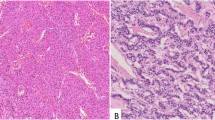Summary
Occurrence and distribution of cytokeratin, neuron specific enolase (NSE) and actin were studied by the immunoperoxidase-antiperoxidase (PAP)-technique using specific antibodies in formalin-fixed, paraffin-embedded material from 6 cases of neurogenic appendicopathy with numerous endocrine cells in the mucosal stroma (SEC), 5 cases of microcarcinoidosis of the stomach, 12 gastrointestinal carcinoids and 4 bronchial carcinoids. Cytokeratin was detectable in all tumor cells. In addition, the epithelial endocrine cells (EEC) and the SEC of intestinal origin were cytokeratin positive. EEC, SEC and cells of microcarcinoids and carcinoids showed a positive immunoreactivity with antibodies to NSE, whereas actin antibodies did not reveal significant staining of these cells. These results strongly suggest that carcinoids of the gastrointestinal tract originate from SEC that have migrated downwards into the stroma from the epithelial layer (“Endophytie” according to Feyrter).
Similar content being viewed by others
References
Auböck L, Ratzenhofer M (1982) “Extraepithelial enterochromaffin cell-nerve-fibre Complexes” in the normal human appendix, and in neurogenic appendicopathy. J Pathol 136:217–226
Auböck L, Höfler H (1983) Extraepithelial intraneural endocrine cells as starting-points for gastrointestinal carcinoids. Virchows Archiv [Pathol Anat] 401:17–33
Capella C, Solcia E, Snell CK (1973) Ultrastructure of endocrine cells and argyrophil carcinoids of the stomach of Praomys (Mastomys) natalensis. J Nath Cancer Inst 50:1471–1485
Denk H, Radaszkiewicz T, Weirich E (1977) Pronase pretreatment of tissue sections enhances sensitivity of the unlabeled antibody (PAP) technique. J Immunol Methods 15:163–167
Denk H, Franke WW, Dragosics B, Zeiler I (1981) Pathology of cytoskeleton of liver cells: demonstration of mallory bodies (alcoholic hyalin) in murine and human hepatocytes by immunofluorescence microscopy using antibodies to cytokeratin polypeptides from hepatocytes. Hepatology 1:9–20
Feyrter F (1934) Carcinoid and Carcinom. Ergebn Allg Pathol Anat 29:305–489
Franke WW, Appelhans B, Schmid E, Freudenstein C, Osborn M, Weber K (1979) Identification and characterization of epithelial cells in mammalian tissue by immunofluorescence microscopy using antibodies to prekeratin. Differentiation 15:7–25
Höfler H, Auböck L, Ratzenhofer M (1982) Die neurogene Appendikopathie. Eine lichtmikroskopische Studie. Normale und pathologische Anatomie. G Thieme, Stuttgart New York, Bd 45
Höfler H, Heitz PHU (1982) Immuncytochemische Befunde bei neurogener Appendicopathie. Wien Klin Wochenschr 21:588–591
Isaacson P (1981) Crypt cell carcinoma of the appendix (so-called adenocarcinoid tumor). Am J Surg Pathol 5:213–224
Lyss AP, Thompson JJ, Glick JH (1981) Adenocarcinoid tumor of the colon arising in preexisting ulcerative colitis. Cancer 48:833–839
Masson P (1924) Appendicite neurogéne et carcinoids. Ann Anat Pathol 1:3–59
Masson P (1932) Neural proliferations in the vermiform appendix. In: Penfield W (ed) Cytology and cellular pathology of the nervous system. Hoeber, New York, pp 1095–1130
Moll R, Krepler R, Franke WW (1983) Complex cytokeratin polypeptide patterns observed in certain human carcinomas differentiation 23:256–269
Osaka M, Kobayashi S (1976) Duodenal basal-granulated cells in the human fetus with special reference to their relationship to nervous elements. In: Fujita T (ed) Endocrine gut and pancreas. Elsevier, Amsterdam, pp 145–158
Rode J, Dhillon AP, Papadaki L, Griffiths D (1982) Neurosecretory cells of the lamina propria of the appendix and their possible relationship to carcinoids. Histopathology 6:69–79
Soga J, Kohro T, Tazawa K, Kanahara H, Sano M, Sakashita T, Tajina K, Morooka H, Karaki Y (1975) Argyrophil cell microneoplasia in Mastomys' stomach - an observation on early carcinoid formation. Natl Can Inst 55:1001–1006
Sternberger LA (1979) The unlabeled antibody peroxidase-antiperoxidase (PAP) method. In: Sternberger LA (ed) Immunocytochemistry (2ed) John Wiley, New York, pp 104–169
Warner CS, Seo IS (1979) Goblet cell carcinoid of appendix. Ultrastructural features and histogenetic aspects. Cancer 44:1700–1706
Author information
Authors and Affiliations
Additional information
Dedicated to Prof Dr. H.G. Klingenberg on the occasion of his 65th birthday.
Rights and permissions
About this article
Cite this article
Höfler, H., Denk, H. Immunocytochemical demonstration of cytokeratin in gastrointestinal carcinoids and their probable precursor cells. Vichows Archiv A Pathol Anat 403, 235–240 (1984). https://doi.org/10.1007/BF00694899
Accepted:
Issue Date:
DOI: https://doi.org/10.1007/BF00694899




